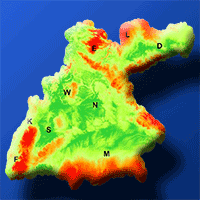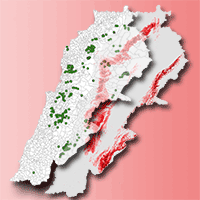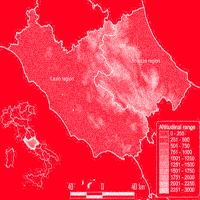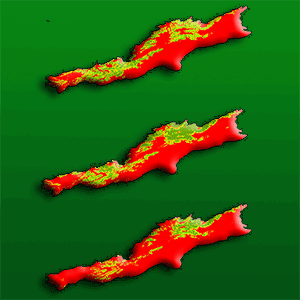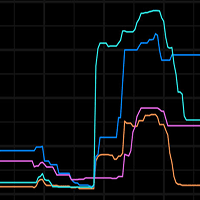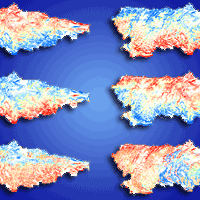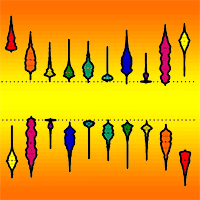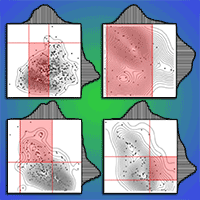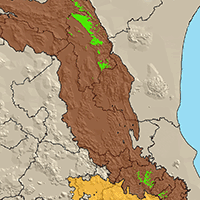European beech (Fagus sylvatica L.) is the most important tree species in Central Europe and is considered to be relatively resistant to climate warming. However, dry summers in the last five years led to considerable damage in beech stands in Southern Germany (SG). Assisted migration of drought resistant beech provenances including those of Oriental beech (Fagus orientalis Lipsky) may help to stabilise Central European beech forests under climate change. The focus of this study is to compare the climatic ranges of F. sylvatica and F. orientalis using quantile distribution of climatic variables based on WorldClim data at forest sites within their natural distribution area. Temperature, precipitation, and aridity quantile ranges showed that F. orientalis is better adapted to warmer and drier climate compared to F. sylvatica. The quantile distribution method was applied to the whole range of the species to map the habitat suitability for both species at marginal sites in the target region (SG) in the current climatic scenario (1970-2000) and in a warmer scenario (+2°C) using the climate marginality index (CMI), i.e., the distance of sites to the xeric edge at low-latitude and low-altitude distribution limits for the species. To this purpose we applied the simple BIOCLIM algorithm using annual temperature and precipitation as climatic variables. According to our results, F. orientalis seems a promising species with a high potential for future afforestation activities in Southern Germany, especially at marginal sites of European beech forests. However, before introducing F. orientalis on a larger scale in the study area, further research on the species ecology and genetics are needed. For further application of the quantile range method, we produced tables of the vigintiles of the climatic range for both species, which can be used for estimating CMI based on WorldClim data in other regions.
Keywords
, , , , , , ,
Citation
Mellert KH, Šeho M (2022). Suitability of Fagus orientalis Lipsky at marginal Fagus sylvatica L. forest sites in Southern Germany. iForest 15: 417-423. - doi: 10.3832/ifor4077-015
Academic Editor
Maurizio Marchi
Paper history
Received: Feb 15, 2022
Accepted: Aug 08, 2022
First online: Oct 19, 2022
Publication Date: Oct 31, 2022
Publication Time: 2.40 months
© SISEF - The Italian Society of Silviculture and Forest Ecology 2022
Open Access
This article is distributed under the terms of the Creative Commons Attribution-Non Commercial 4.0 International (https://creativecommons.org/licenses/by-nc/4.0/), which permits unrestricted use, distribution, and reproduction in any medium, provided you give appropriate credit to the original author(s) and the source, provide a link to the Creative Commons license, and indicate if changes were made.

Breakdown by View Type
(Waiting for server response...)
Article Usage
Total Article Views: 27293
(from publication date up to now)
Breakdown by View Type
HTML Page Views: 23078
Abstract Page Views: 2131
PDF Downloads: 1688
Citation/Reference Downloads: 3
XML Downloads: 393
Web Metrics
Days since publication: 1153
Overall contacts: 27293
Avg. contacts per week: 165.70
Article Citations
Article citations are based on data periodically collected from the Clarivate Web of Science web site
(last update: Mar 2025)
Total number of cites (since 2022): 8
Average cites per year: 2.00
Publication Metrics
by Dimensions ©
Articles citing this article
List of the papers citing this article based on CrossRef Cited-by.
(1)
Andrade C, Corte-Real J (2016)Aridity conditions in the Iberian Peninsula during the XX century. International Journal of Education and Learning Systems 1: 52-58.
Gscholar
(2)
Ayan S, Bugday E, Varol T, Ozel HB, Thurm AE (2022)Effect of climate change on potential distribution of oriental beech (
Fagus orientalis Lipsky) in the twenty-first century in Turkey. Theoretical and Applied Climatology 148: 165-177.
CrossRef |
Gscholar
(3)
Bohn U, Neuhäusl R (2003)Karte der natürlichen Vegetation Europas. Maßstab 1: 2.500.000) [Map of the Natural Vegetation of Europe]. Landwirtschaftsverlag, Münster, Germany, pp. 655. [in German]
Gscholar
(4)
Booth TH, Nix HA, Busby JR, Hutchinson MF (2014)BIOCLIM: the first species distribution modelling package, its early applications and relevance to most current MAXENT studies. Diversity and Distributions 20 (1): 1-9.
CrossRef |
Gscholar
(5)
Brang P, Spathelf P, Larsen JB, Bauhus J, Boncčìna A, Chauvin C, Svoboda M (2014)Suitability of close-to-nature silviculture for adapting temperate European forests to climate change. Forestry 87 (4): 492-503.
CrossRef |
Gscholar
(6)
Buchhorn M, Smets B, Bertels L, De Roo B, Lesiv M, Tsendbazar NE, Linlin L, Tarko A (2020)Copernicus global land service: land cover 100 m, version 3 Globe 2015-2019 - Product user manual. Zenodo, Geneve, Switzerland, pp. 44.
CrossRef |
Gscholar
(7)
Busby JR (1991)BIOCLIM - A bioclimate analysis and prediction system. Plant Protection Quarterly 6: 8-9.
Gscholar
(8)
Cai Q, Welk E, Ji C, Fang W, Sabatini FM, Zhu J, Bruelheide H (2021)The relationship between niche breadth and range size of beech (
Fagus) species worldwide. Journal of Biogeography 48 (5): 1240-1253.
CrossRef |
Gscholar
(9)
Caudullo G, Welk E, San-Miguel-Ayanz J (2017)Chorological maps for the main European woody species. Data in brief 12: 662-666.
CrossRef |
Gscholar
(10)
Conrad V (1946)Usual formulas of continentality and their limits of validity. Eos, Transactions American Geophysical Union 27 (5): 663-664.
CrossRef |
Gscholar
(11)
Dagtekin D, Sahan EA, Denk T, Köse N, Dalfes HN (2020)Past, present and future distributions of Oriental beech (
Fagus orientalis) under climate change projections. PloS One 15 (11): e0242280.
CrossRef |
Gscholar
(12)
Daly C, Widrlechner MP, Halbleib MD, Smith JI, Gibson WP (2012)Development of a new USDA plant hardiness zone map for the United States. Journal of Applied Meteorology and Climatology 51 (2): 242-264.
CrossRef |
Gscholar
(13)
Dorado-Liñán I, Piovesan G, Martínez-Sancho E, Gea-Izquierdo G, Zang C, Cañellas I, Castagneri D, Di Filippo A, Gutiérrez E, Ewald J, Fernández-De-Uña L, Hornstein D, Jantsch MC, Levanič T, Mellert KH, Vacchiano G, Zlatanov T, Menzel A (2019)Geographical adaptation prevails over species-specific determinism in trees’ vulnerability to climate change at Mediterranean rear-edge forests. Global Change Biology 25 (4): 1296-1314.
CrossRef |
Gscholar
(14)
DWD (2021)Auswahl klimatologischer kennwerte für Deutschland [Selection of climatological parameters for Germany]. Deutscher Wetterdienst - DWD, Germany, Web site. [in German]
Online |
Gscholar
(15)
Ellenberg HH (1988)Vegetation ecology of Central Europe. University Press, Cambridge, UK, pp. 731.
Online |
Gscholar
(16)
Fang J, Lechowicz MJ (2006)Climatic limits for the present distribution of beech (
Fagus L.) species in the world. Journal of Biogeography 33 (10): 1804-1819.
CrossRef |
Gscholar
(17)
Fick SE, Hijmans RJ (2017)WorldClim 2: new 1-km spatial resolution climate surfaces for global land areas. International Journal of Climatology 37 (12): 4302-4315.
CrossRef |
Gscholar
(18)
Franklin J (2010)Mapping species distributions: spatial inference and prediction. University Press, Cambridge, UK, pp. 320.
CrossRef |
Gscholar
(19)
Hampe A, Petit RJ (2005)Conserving biodiversity under climate change: the rear edge matters. Ecology Letters 8 (5): 461-467.
CrossRef |
Gscholar
(20)
Heinrichs S, Walentowski H, Bergmeier E, Mellert KH, Indreica A, Kuzyakov Y, Leuschner C, Petritan AM, Teodosiu M (2016)Forest vegetation in western Romania in relation to climate variables: does community composition reflect modelled tree species distribution? Annals of Forest Research 59 (2): 219-236.
CrossRef |
Gscholar
(21)
Hijmans RJ, Graham CH (2006)The ability of climate envelope models to predict the effect of climate change on species distributions. Global Change Biology 12 (12): 2272-2281.
CrossRef |
Gscholar
(22)
Hijmans RJ, Phillips S, Leathwick J, Elith J (2017)dismo: species distribution modeling. R package version 1:1-4.
Online |
Gscholar
(23)
Höhn M, Major E, Avdagić A, Bielak K, Bosela M, Coll L, Dinca L, Giammarchi F, Ibrahimspahi A, Mataruga M, Pach M, Uhl E, Zlatanov T, Cseke K, Kovács Zs Palla B, Ladányi M, Heinze B (2021)Local characteristics of the standing genetic diversity of European beech with high within-region differentiation at the eastern part of the range. Canadian Journal of Forest Research 51 (12): 1791-1798.
CrossRef |
Gscholar
(24)
Hohnwald S, Indreica A, Walentowski H, Leuschner C (2020)Microclimatic tipping points at the beech-oak ecotone in the Western Romanian Carpathians. Forests 11 (9): 919.
CrossRef |
Gscholar
(25)
Houston Durrant T, De Rigo D, Caudullo G (2016)Fagus sylvatica in Europe: distribution, habitat, usage and threats. In: “European Atlas of Forest Tree Species” (San-Miguel-Ayanz J, De Rigo D, Caudullo G, Houston Durrant T, Mauri A eds). Publication Office of the European Union, Luxembourg, pp. 94-95.
Online |
Gscholar
(26)
Huntley B, Bartlein PJ, Prentice IC (1989)Climatic control of the distribution and abundance of beech (
Fagus L.) in Europe and North America. Journal of Biogeography 16 (6): 551-560.
Online |
Gscholar
(27)
Hutchinson GE (1957)Population studies-animal ecology and demography-concluding remarks. Cold Spring Harbor Symposia on Quantitative Biology 22: 415-427.
CrossRef |
Gscholar
(28)
Kandemir G, Kaya Z (2009)EUFORGEN technical guidelines for genetic conservation and use of Oriental beech (
Fagus orientalis). Bioversity International, Rome, Italy, pp. 6.
Gscholar
(29)
Kasper J, Weigel R, Walentowski H, Gröning A, Petritan AM, Leuschner C (2021)Climate warming-induced replacement of mesic beech by thermophilic oak forests will reduce the carbon storage potential in aboveground biomass and soil. Annals of Forest Science 78 (4): 1-34.
CrossRef |
Gscholar
(30)
Knoke T, Ammer C, Stimm B, Mosandl R (2008)Admixing broadleaved to coniferous tree species: a review on yield, ecological stability and economics. European Journal of Forest Research 127 (2): 89-101.
CrossRef |
Gscholar
(31)
Mellert KH, Deffner V, Küchenhoff H, Kölling C (2015)Modeling sensitivity to climate change and estimating the uncertainty of its impact: a probabilistic concept for risk assessment in forestry. Ecological Modelling 316: 211-216.
CrossRef |
Gscholar
(32)
Mellert KH, Ewald J, Hornstein D, Dorado-Liñán I, Jantsch M, Taeger S, Kölling C (2016)Climatic marginality: a new metric for the susceptibility of tree species to warming exemplified by Fagus sylvatica (L.) and Ellenberg’s quotient. European Journal of Forest Research 135 (1): 137-152.
CrossRef |
Gscholar
(33)
Mellert KH, Fäth J, Falk W, Wellbrock N, Göttlein A (2020)The ecological base amplitude of tree species in Germany. Allgemeine Forst- und Jagdzeitung 190 (7-8): 184-204.
Online |
Gscholar
(34)
Mellert KH, Janssen A, Seho M (2021)Wo finden wir Alternativherkünfte der Buche für den Klimawandel? [Where can we find alternative sources of beech for climate change?]. Allgemeine Forstzeitung/Der Wald 24: 16-20. [in German]
Gscholar
(35)
Mellert KH, Lenoir J, Winter S, Kölling C, Carni A, Dorado-Liñán I, Juvan N, Kolb E, López-Senespleda E, Menzel A, Stojanović D, Täger S, Tsiripidis I, Wohlgemuth T, Ewald J (2018)Soil water storage appears to compensate for climatic aridity at the xeric margin of European tree species distribution. European Journal of Forest Research 137 (1): 79-92.
CrossRef |
Gscholar
(36)
Muffler L, Beierkuhnlein C, Aas G, Jentsch A, Schweiger AH, Zohner C, Kreyling J (2016)Distribution ranges and spring phenology explain late frost sensitivity in 170 woody plants from the Northern Hemisphere. Global Ecology and Biogeography 25 (9): 1061-1071.
CrossRef |
Gscholar
(37)
Paffetti D, Vettori C, Caramelli D, Vernesi C, Lari M, Paganelli A, Giannini R (2007)Unexpected presence of
Fagus orientalis complex in Italy as inferred from 45.000-year-old DNA pollen samples from Venice lagoon. BMC Evolutionary Biology 7 (2): 1-13.
CrossRef |
Gscholar
(38)
Pastorelli R, Smulders MJ, Van’t Westende WPC, Vosman B, Giannini R, Vettori C, Vendramin GG (2003)Characterization of microsatellite markers in Fagus sylvatica L. and Fagus orientalis [Lipsky]. Molecular Ecology Notes 3 (1): 76-78.
CrossRef |
Gscholar
(39)
Postolache D, Oddou-Muratorio S, Vajana E, Bagnoli F, Guichoux E, Hampe A, Le Provost G, Lesur I, Popescu F, Scotti I, Piotti A, Vendramin GG (2021)Genetic signatures of divergent selection in European beech (
Fagus sylvatica L.) are associated with the variation in temperature and precipitation across its distribution range. Molecular Ecology 30 (20): 5029-5047.
CrossRef |
Gscholar
(40)
QGIS.org (2022)QGIS Geographic Information System. QGIS Association, web site.
Online |
Gscholar
(41)
R Core Team (2019)R: a language and environment for statistical computing. R Foundation for Statistical Computing, Vienna, Austria.
Online |
Gscholar
(42)
Sánchez De Dios R, Gómez C, Aullo I, Canellas I, Gea-Izquierdo G, Montes F, Sainz-Ollero H, Velázquez JC, Hernández L (2021)Fagus sylvatica L. peripheral populations in the Mediterranean Iberian peninsula: climatic or anthropic relicts? Ecosystems 24 (1): 211-226.
CrossRef |
Gscholar
(43)
Stojanović DB, Krič A, Matović B, Orlović S, Duputie A, Djurdjević V, Stojnić S (2013)Prediction of the European beech (
Fagus sylvatica L.) xeric limit using a regional climate model: an example from southeast Europe. Agricultural and Forest Meteorology 176: 94-103.
CrossRef |
Gscholar
(44)
Svoboda P (1953)Forest tree species and their stands. SZN Publishing, Prague, Czech Republic, pp. 411.
Gscholar
(45)
Thurm EA, Hernandez L, Baltensweiler A, Ayan S, Rasztovits E, Bielak K, Falk W (2018)Alternative tree species under climate warming in managed European forests. Forest Ecology and Management 430: 485-497.
CrossRef |
Gscholar
(46)
Von Wühlisch G (2008)EUFORGEN technical guidelines for genetic conservation and use for European beech (
Fagus sylvatica). Bioversity International, Rome, Italy, pp. 6.
Gscholar
(47)
Von Wühlisch G, Muhs HJ (2010)Current state of European beech (
Fagus sylvatica L.) forests in Germany. Communicationes Instituti Forestalis Bohemicae 25: 113-121.
Gscholar
(48)
Walentowski H (2019)Nemoral deciduous forests under climatic extremes - Phytosociological studies along climatic gradients in SW Romania. Forest and sustainable development. Transilvania University Press, Brasov, Romania, pp. 139-148.
Gscholar
